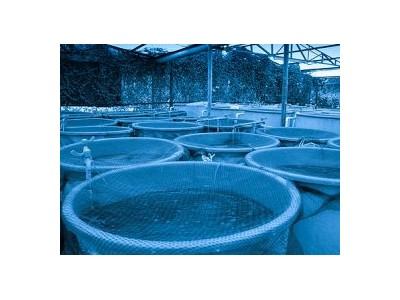Egyptian Aquaculturalists Best Management Practice Training Boosts Profits

EGYPT - Best management practice training helps Egyptian aquaculturalists improve their net profits, a new study lead by Dr Malcolm Dickson, Country Programme Manager for Egypt at WorldFish reveals, writes Sam Andrews for The Fish Site.
Published in the journal Aquaculture, the findings offer hope to Egyptian aquaculturalists who have seen declines in profits in more recent years, putting both food security and livelihoods at risk.
Whilst Egyptian aquaculture, which is dominated by pond-based tilapia and mullet, has seen significant increases in production over the past 30 years, training opportunities have not matched this growth. Lack of training has been identified as one of the reasons for the financial predicament many of Egypt’s aquaculturalists are finding themselves in.
Developed with Egyptian-based experts, WorldFish introduced Best Management Practice training programme in 2012 under their project Improving Employment and Income through Development of Egypt’s Aquaculture Sector (IEIDEAS).
The programme offered practical, in the field training to farmers operating around the Nile Delta lakes – the hub of Egypt’s aquaculture production, on a range of topics including stocking rates, fertiliser use, and feed management techniques.
Despite concerns that aquaculturalists would see the training as additional work with no discernible market advantage, by the end of 2014 the programme had successfully trained some 2,400 farmers and managers from approximately 1,800 farms.
Aquaculturalists who participated in the Best Management Practice programme saw significantly higher average net profits in 2015 than their untrained counterparts - over U$15,000 more for an average-sized (7.5 hectare) farm. Collectively, the trained aquaculturalists produced U$18.9 million more in profits. At the time the survey took place, most trained aquaculturalists only had a year to implement what they had learned. Ongoing adjustments and improvements over the coming years could result in further profit increases.
Most of this extra profit came from improvements in variable operational costs, and not from sales income or for fixed costs like land rent or taxes, which were the same for trained and untrained aquaculturalists.
Feed costs in particular declined significantly for trained aquaculturalists, who spent an average of U$1,314 per hectare a year less on feed than their untrained counterparts. After implementing the advice and techniques learned during the Best Management Practice programme, trained aquaculturalists were able to achieve higher food conversion ratios. Other costs, like fuel and electricity, were also lower though the differences far less dramatic.
Some costs did go up for the trained aquaculturalists, though in line with what was expected from the training. The use of fertilizers, for example, can increase the growth of plankton in ponds, providing a relatively cheap, high quality food source for the farmed fish. Whilst around 63 per cent of untrained aquaculturalists did not use any fertilizer, 92.7 per cent for trained aquaculturalists did.
Furthermore, trained aquaculturalists used much more fertilizer for a shorter grow-out time, and favoured organic over chemical-based fertilizers.
Not all of the training was necessarily applied well across the farms. The ability to harvest larger sized fish by reducing overall stocking rates was one of the key messages of the training, however trained aquaculturalists tended to apply the same stocking rates as their untrained counterparts.
Indeed, only thin-lip mullet showed any significant difference in average harvest weight between trained and untrained aquaculturalists, though trained aquaculturalists ended up with significantly less small-sized tilapia.
“There’s always pressure from hatcheries to sell more fry and fingerlings”, Dr Dickson considered on the reasons for the lack of difference in stocking rates.
“Egyptian fish farmers tend to stock at a very small size, soon after the fry have been sex reversed and there’s huge competition between hatcheries so the cost of stocking a pond is relatively low. This makes it tempting to stock more fish rather than reducing the stocking rate”.
WorldFish have already launched a new training programme under The Sustainable Transformation of Egypt’s Aquaculture Market System (STREAMS) project.
“The new training is extending into areas where farmers didn’t receive training under the IEIDEAS project and is more focused on the topics that had most impact in the IEIDEAS project,” Dr Dickson explained.
The new programme hopes to reach at least 4,000 additional farms across Egypt, assisting 44,750 direct beneficiaries and some 3.9 million indirect beneficiaries.
Sam Andrews, Freelance journalist
Samantha is a marine conservation biologist/ecologist. She holds an MSc in Marine Environmental Management, an Advanced Graduate Diploma (3/4 of a Masters) in Fisheries Management, and is currently undertaking a PhD focusing on marine spatial management for conservation and sustainable ocean use. She has worked closely alongside Government, NGOs, and the fishing industry to help improve the ways in which we interact with the ocean. When she is not doing science, she works as a marine science communicator.
Có thể bạn quan tâm
 Pangasius, vegetable prices highly hike in Mekong Delta
Pangasius, vegetable prices highly hike in Mekong Delta Pangasius prices have surged to the record high of VND27,000-28,000 a kilogram, bringing breeders a profit of VND4,000-6,000 a kilogram,
 Vietnam able to master parent shrimp production
Vietnam able to master parent shrimp production Vietnam could become self-sufficient in parent shrimp production from now to 2020. Vietnam able to master parent shrimp production
 Seafood exporters pledge to combat IUU fishing
Seafood exporters pledge to combat IUU fishing Vietnamese seafood processing and exporting companies have committed to combating illegal, unreported and unregulated (IUU) fishing
 Can aquaculture help with mineral, vitamin deficiencies?
Can aquaculture help with mineral, vitamin deficiencies? This advance in technology would result in the reduction of the use of wood fires for cooking, decreasing the need for disposal of wood ashes in garden soils.
 Vietnam, Norway share experience in aquaculture cultivation
Vietnam, Norway share experience in aquaculture cultivation Norway, the world’s leading seafood exporter, shared its experience in applying advanced technology for aquaculture farming and processing at a conference